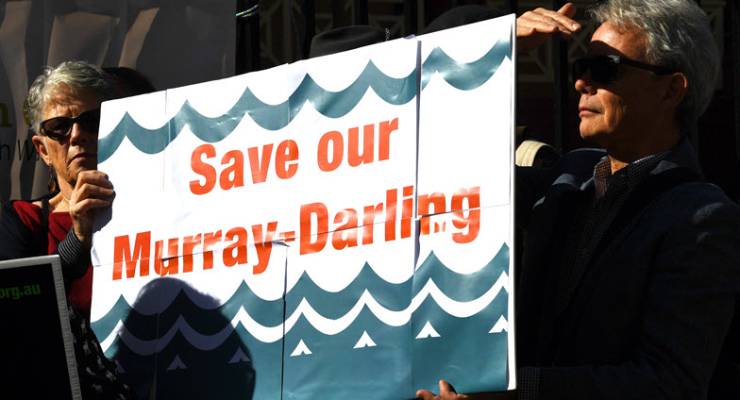
Much has been made of alleged water theft and lack of political willpower as reasons for the Murray-Darling Basin Plan’s demonstrable failure. And while sure, New South Wales is pulling out of a plan the government failed to monitor and enforce at any rate, experts are now pointing to a fundamental misunderstanding of ecological systems — namely return flow, and poorly thought-out irrigation infrastructure — as a sign that the $13 billion plan was doomed before it began.
Of the $6 billion already spent on the Murray-Darling Basin Plan, some $4 billion has been spent on water recovery infrastructure projects that, according to a recent report delivered by University of South Australia Economics Professor Lin Crase and 11 other water experts, offer “no scientific evidence that they have actually increased net stream flows”.
Rather, signatories of the Murray-Darling Declaration argue that “much more could have been achieved for far less, as federal government data shows that buying water from willing sellers is 60% cheaper than building questionable engineering works”.
Crase tells Crikey the focus on sophisticated irrigation infrastructure, however well-intentioned, has counterintuitively delivered less water for the environment by recycling “lost” water that would have instead been returned to the broader environment.
As an example, he offers a hypothetical farmer who traditionally pumps 100 megalitres (Ml) over their trees — only 20Ml of which is absorbed by plant life, 40Ml of which stays in the soil, and the final 40Ml of which leaks and “accidentally almost keeps the wetland alive next door”.
However, the farmer now decides to sell 20Ml to the government’s environmental effort and, crucially, uses the proceeds to install special drains that can recycle their 80Ml of water in its entirety.
“Now think about that whole transaction: the government bought 20Ml for the water to preserve wetlands, and the consequence has been that the government now has half as much water to put into the wetlands than it did previously. And basically, that’s what we’ve been doing throughout the whole basin.”
Basically, the more efficient the irrigation infrastructure, the less opportunity for water to return to the broader ecological system.
And while groups such as the Murray-Darling Basin Authority have highlighted rampant non-compliance over meterable (i.e. surface level water and groundwater) and even some non-meterable (i.e. floodplain harvesting) water sources, Crase says not enough has been done in Australia to account for, let alone measure, these return flows.
Indeed, two other academics and signatories to the declaration, Professor R. Quentin Grafton and John Williams, found that a 2017 Productivity Commission Draft Report on National Water Reform showed a “complete absence of any significant discussion about return flows from irrigation, although it was identified in the ATSE submission and noted in the Draft Report as a research need”.
“This is despite the fact that the Draft Report identified as one of the successes of past water reform as improved ‘water use efficiency’,” they wrote.
Crase is now arguing for three changes to the plan, explained further in the Declaration Recommendations:
“First thing is stop wasting money on irrigation infrastructure, because we don’t know whether it works and we’re pretty confident that the numbers that are there are wrong. Second of all let’s do an audit of what actually has been purchased for the environment, and work out where it is or whether it’s just imaginary water.
“And thirdly, make sure we have a body that is at arm’s length from the politics of it all that can actually check and keep an eye on these things, and make sure that governments are not just marking their own score cards.”
To that final point, he advocates for a body similar to the National Water Commission. While Crase states it was “a bit of a toothless tiger”, he contends it acted as an independent statutory body that “at least had the ability to call bad practice out [and] call out the states” before it was abolished by the Abbott government in 2014.
As to technological solutions to the lack of data on return flows, Crase suggests a greater incorporation of satellite technology — a common solution across international monitoring initiatives. Still, this belies his overarching point that subsidising irrigation infrastructure is an unproven and costly initiative at best and, at worst, actually detrimental to the environment.
“Many of us have spent the last 10 years explaining to various politicians, various government inquiries, goodness knows what, about the nonsense of this whole water use efficiency debate and the nonsense of subsidising irrigation in order to achieve the objectives of the Basin Plan.”
“But it’s got us nowhere and what we’ve managed to do is spend $6 billion with a very strong prospect of much, much less water for the environment than what people have been told.”








Crikey is committed to hosting lively discussions. Help us keep the conversation useful, interesting and welcoming. We aim to publish comments quickly in the interest of promoting robust conversation, but we’re a small team and we deploy filters to protect against legal risk. Occasionally your comment may be held up while we review, but we’re working as fast as we can to keep the conversation rolling.
The Crikey comment section is members-only content. Please subscribe to leave a comment.
The Crikey comment section is members-only content. Please login to leave a comment.